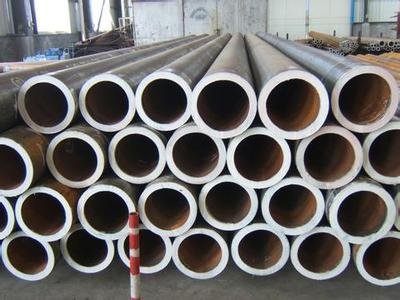The hardness test of the seamless pipe should take into account its mechanical properties, which is related to the performance and quality of deformation, stamping, cutting and other processing using stainless steel as raw material. Therefore, all seamless steel pipes should be tested for mechanical properties. There are two main types of mechanical property testing methods, one is tensile test and the other is hardness test.
In the tensile test, the seamless steel pipe is made into a sample, and the sample is pulled to fracture on a tensile testing machine. Then determine one or several mechanical properties, usually only tensile strength, yield strength, elongation after fracture and reduction of area. Tensile test is the basic mechanical performance test method of metal materials. Almost all metal materials, as long as there are requirements for mechanical properties, have specified tensile tests. Especially for those materials whose shapes are not convenient for hardness testing, tensile testing has become the only means of testing mechanical properties. The hardness test is to slowly press a hard indenter into the surface of the sample according to the specified conditions, and then test the depth or size of the indentation to determine the hardness of the material. Hardness test is a simple, rapid and easy-to-dry method in material mechanical performance test. The hardness test is non-destructive, and there is an approximate conversion relationship between the estimated hardness of the material and the estimated tensile strength, and the hardness value of the material can be converted into the tensile strength value.

Since the tensile test is not convenient for testing, and it is very convenient to convert from hardness to strength, more and more people only test the hardness of materials and seldom test their strength. Especially due to the continuous improvement and innovation of the hardness tester manufacturing technology, some materials that could not be directly tested for hardness, such as seamless steel pipes, stainless steel plates and stainless steel strips, etc., are now possible to test the hardness by themselves. Therefore, there is a tendency that the hardness test gradually replaces the tensile test.
For annealed seamless steel pipes with an inner diameter of more than 6.0 mm and a wall thickness of less than 13 mm, W-B75 Webster hardness tester can be used. It is very fast and simple to test, and is suitable for quick and non-destructive qualification inspection of seamless steel pipes. For seamless steel pipes with an inner diameter of up to 30mm and a wall thickness greater than 1.2mm, use a Rockwell hardness tester to test the hardness of HRB and HRC. For seamless steel pipes with an inner diameter greater than 30mm and a wall thickness less than 1.2mm, the surface Rockwell hardness tester is used to test the hardness of HRT or HRN. For seamless steel pipes with an inner diameter less than 0mm and greater than 4.8mm, use a special Rockwell hardness tester for pipes to test the hardness of HR15T. When the inner diameter of the seamless steel pipe is greater than 26mm, the hardness of the inner wall of the pipe can also be tested with a Rockwell or superficial Rockwell hardness tester.
In the tensile test, the seamless steel pipe is made into a sample, and the sample is pulled to fracture on a tensile testing machine. Then determine one or several mechanical properties, usually only tensile strength, yield strength, elongation after fracture and reduction of area. Tensile test is the basic mechanical performance test method of metal materials. Almost all metal materials, as long as there are requirements for mechanical properties, have specified tensile tests. Especially for those materials whose shapes are not convenient for hardness testing, tensile testing has become the only means of testing mechanical properties. The hardness test is to slowly press a hard indenter into the surface of the sample according to the specified conditions, and then test the depth or size of the indentation to determine the hardness of the material. Hardness test is a simple, rapid and easy-to-dry method in material mechanical performance test. The hardness test is non-destructive, and there is an approximate conversion relationship between the estimated hardness of the material and the estimated tensile strength, and the hardness value of the material can be converted into the tensile strength value.

Since the tensile test is not convenient for testing, and it is very convenient to convert from hardness to strength, more and more people only test the hardness of materials and seldom test their strength. Especially due to the continuous improvement and innovation of the hardness tester manufacturing technology, some materials that could not be directly tested for hardness, such as seamless steel pipes, stainless steel plates and stainless steel strips, etc., are now possible to test the hardness by themselves. Therefore, there is a tendency that the hardness test gradually replaces the tensile test.
For annealed seamless steel pipes with an inner diameter of more than 6.0 mm and a wall thickness of less than 13 mm, W-B75 Webster hardness tester can be used. It is very fast and simple to test, and is suitable for quick and non-destructive qualification inspection of seamless steel pipes. For seamless steel pipes with an inner diameter of up to 30mm and a wall thickness greater than 1.2mm, use a Rockwell hardness tester to test the hardness of HRB and HRC. For seamless steel pipes with an inner diameter greater than 30mm and a wall thickness less than 1.2mm, the surface Rockwell hardness tester is used to test the hardness of HRT or HRN. For seamless steel pipes with an inner diameter less than 0mm and greater than 4.8mm, use a special Rockwell hardness tester for pipes to test the hardness of HR15T. When the inner diameter of the seamless steel pipe is greater than 26mm, the hardness of the inner wall of the pipe can also be tested with a Rockwell or superficial Rockwell hardness tester.









